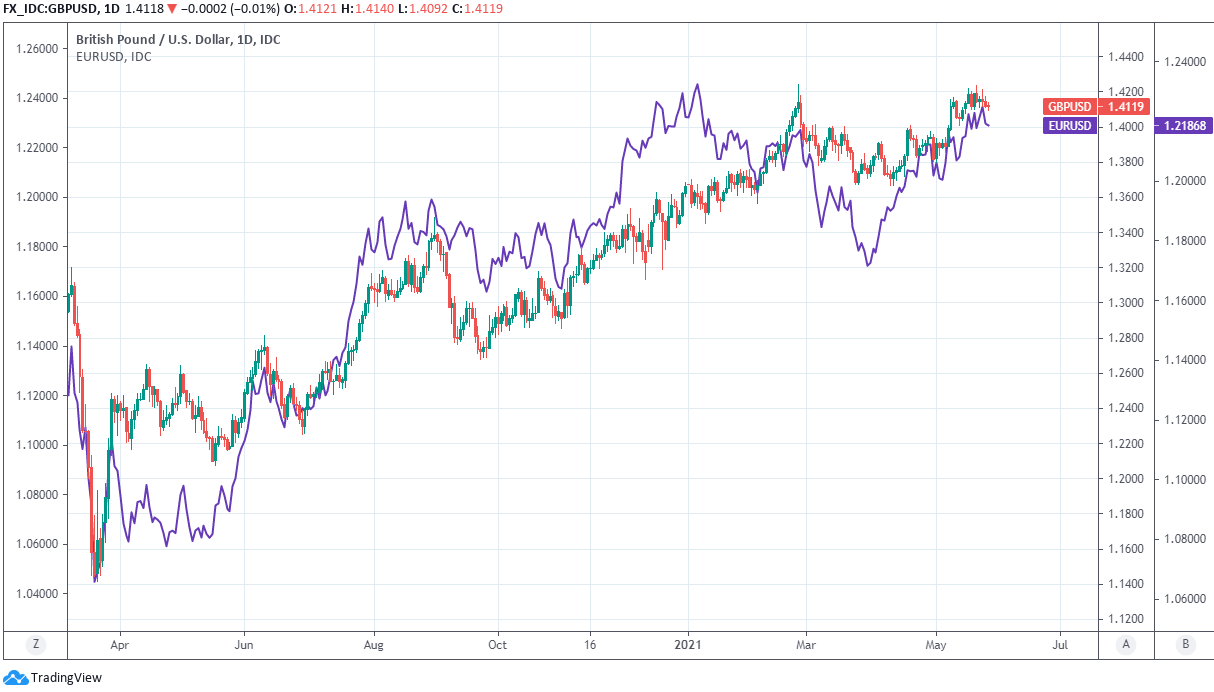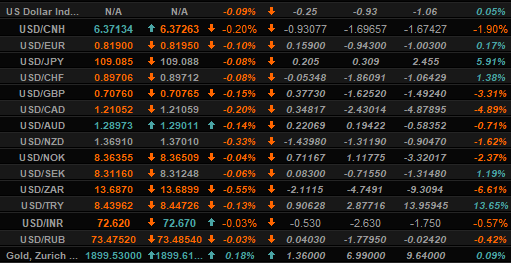Pound-Dollar and EUR/USD Hold Hands On Hips as Renminbi and Rand Stand Tall
- Written by: James Skinner
-
- GBP/USD treads water at 1.41 as EUR/USD loiters at 1.22
- USD recedes at glacial pace while CNH and ZAR stand tall
- FX rates inflate or deflate inflation-concerned economies

Image © Adobe Images
- GBP/USD reference rates at publication:
- Spot: 1.4143
- Bank transfers (indicative guide): 1.3740-1.3840
- Money transfer specialist rates (indicative): 1.3880-1.4030
- More information on securing specialist rates, here
- Set up an exchange rate alert, here
The Pound-to-Dollar exchange rate slipped into the penultimate session of the week alongside EUR/USD as the greenback retreated from other currencies at a glacial pace, while the Renminbi and Rand stood tall in a foreign exchange market that is becoming increasingly concerned with inflation.
Pound Sterling and the Euro were treading water against the Dollar on Thursday while the greenback was itself receding at a glacial pace from the week’s highs against others in a market where the Chinese Renminbi was headed toward new multi-year peaks.
“GBP/USD continues to hold below 1.4238/45, the recent high and the March 2018 high, and we would allow for some near term consolidation,” says Karen Jones, head of technical analysis for currencies, commodities and bonds at Commerzbank.
“EUR/USD’s new high has not been confirmed by the daily RSI, which is now seeing major divergence. We have partially covered our long positions and would tighten up stops for the rest,” Jones adds.
In the G10 sphere the strongest of currencies was for a second day running the New Zealand Dollar, while at the bottom of the pile there were the Swiss Franc and Japanese Yen.
In between those extremities, European currencies were lagging while the Australian and Canadian commodity Dollars were leading.
Above: Pound-Dollar rate shown at daily intervals alongside EUR/USD.
Secure a retail exchange rate that is between 3-5% stronger than offered by leading banks, learn more.
“The JP Morgan Asia Dollar Index’s advance from its midMay low at 108.54 is taking it back towards the 109.50 current May high, a rise above which will have the January and February highs at 109.81/110.17 in its sights,” says Axel Rudolph, a senior technical analyst and Commerzbank colleague of Jones.
Elsewhere in the world, China’s Renminbi had reached its highest level against the Dollar since May 2018, while Asian currencies more generally were also outperforming alongside a collection of emerging market units.
{wbamp-hide start}{wbamp-hide end}{wbamp-show start}{wbamp-show end}
These emerging market currencies included the South African Rand, which reached its strongest against the Dollar since February 2019.
“The Bank of Korea’s tone has clearly turned more hawkish compared to April as it raised its growth forecast sharply and expects inflation to be higher this year,” saus Ho Woei Chen, CFA and economist at UOB Bank in Singapore.
Above: U.S. Dollar exchange rate quotes and performances. Source: Netdania Markets.
The only obvious common denominator in the above pecking order of performance seen on Thursday at least was inflation and the relative degree of difficulty that individual central banks have typically had when it comes to delivering targeted levels of inflation.
Central banks do have inflation targets, and it’s in the pursuit of these targets that they tinker with interest rates or make use of other monetary policy tools like quantitative easing, although many have struggled persistently to deliver these over recent years if not for longer.
In the modern economic and financial systems inflation is deemed a necessary evil, and is one which has always been difficult to tame or otherwise control including during the current era.
Currently inflation exists in surplus across many emerging market economies for instance - leading to higher interest rates than otherwise - while across major industrialised economies it exists in systemic deficit albeit to varying degrees.
Currency exchange rates however, can and do at the margins have influence on inflation trends through the impact that currency fluctuations have on the cost of imported goods and services, changes of which can easily filter into consumer prices and official measures of inflation.
Above: USD/CNH shown at daily intervals alongside USD/ZAR.
There’s no better illustration of this point then the ongoing rally of the Renminbi, which broke to new multi-year highs against the Dollar this week and within days of it emerging that researchers at the Peoples’ Bank of China (PBoC) had suggested allowing the Chinese currency to appreciate against the greenback in order to offset the impact that rising commodity prices have had on the cost of imported production goods and profit margins for companies.
Higher import costs stemming from falling exchange rates can lift inflation and vice versa, although the market hasn’t always been good at making use of that influence and has often been wasteful of it, with Euro-Dollar and the European Central Bank (ECB) the best example of the latter.
Meanwhile, the South African Reserve Bank (SARB) and others have often struggled to reign in excessive inflation pressures yet been lumbered with inflationary currency depreciation which further lifts inflation, or simply been saddled with currency trends which then do little to aid in the bank’s endeavour.
It may still be early days and somewhat premature for suggestions that the currency market has been in any way seriously reformed, although the pecking order of performance on Thursday at least could be a tentative indication of something like that being the pipeline.
Few central bankers in the world would ever be heard grumbling about that, which is why readers could do worse than attempt to understand the market in the context of the impact that exchange rate trends are having on central bank inflation targets wherever doing otherwise leads to inconsistent results.







